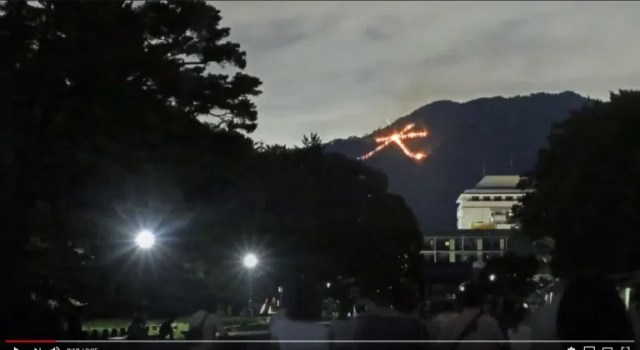
Gozan no Okuribi organizers strike a balance between tradition and safety.
Every year in August, during the Obon season in Japan, Kyoto holds the Gozan no Okuribi event in which gigantic shapes are created in fire on cleared areas of five mountains. The name “okuribi” means “send-off fire” as it’s meant to wish farewell to the spirits of ancestors who visited during Obon.
Having watched that video you may have spotted many instances of crowds gathering to either create the elaborate fires or simply watch them from afar. It’s a big draw, and last year some 28,000 people were said to have viewed the Gozan no Okuribi.
However, in the year of COVID-19 that just won’t do, and a cancellation was seriously considered for the first time since World War II. This is a decision not taken lightly by the organizers who consist of local families who have passed down this tradition throughout generations.
To make matters worse, no one can really say how long the effects of this pandemic will carry on for. The longer this tradition is pushed aside for the sake of social distancing, the more at risk of disappearing forever it becomes.
So, in order to keep the okuribi alive and also prevent large groups of people from congregating, the families behind it believe they have found an elegant solution: They’re going to make it suck.
I mean that in the best possibly way though. It’s actually quite clever, in that they are drastically reducing the number of fires in each of the five designs so that they are as underwhelming as possible while still being somewhat unique and, more importantly, still burning.
The centerpiece of the Gozan no Okuribi is the Daimonji, a kanji character for “big” which is lit first and consists of 75 separate bonfires.
This year, however, only six of those fires will be lit.
▼ Computer simulation
A few minutes later the Myo and Ho kanji characters that express Buddhism ideology are lit, but this year will be reduced from 166 fires to two.
▼ Computer simulation
Next up is the self-explanatory Funagata or “Boat Shape” which is getting knocked down to a single fire from it’s original 79.
▼ Computer simulation
The Daimonji fire is so nice that they do it twice, but instead of the 53 fires that go into the Hidari Daimonji, there will now be one.
▼ Computer simulation
Finally the Toriigata representing the gates in front of Shinto shrines usually has the most fires for a single shape at 108.
In 2020 though, it will only have two.
▼ Computer simulation
“Festive” certainly isn’t the word I’d use for these new designs, but drastic times call for drastically reduced fires. Others in Japan also expressed their disappointment in the news, but also took the opportunity to remember its true meaning.
“It’s unavoidable…”
“I wonder if they’ll still broadcast these dots on TV.”
“I think they should do it as usual out of respect for the dead.”
“On the bright side it’s a good test of your imagination.”
“I thought I was reading a satirical news site at first.”
“It’s like looking at constellations.”
“People forget that it’s a ritual, not a spectacle. It’s more important that they carry on than make a show for the rest of us.”
The organizers also mentioned that honoring those who had succumbed to COVID-19 was a part of the motivation to carry on the tradition in a reduced form.
There is still a possibility that this might backfire and people will head out into the most popular lookout spots to get a picture of this rare configuration of fires anyway. But the organizers did a pretty good job at making these new arrangements look incredibly boring. So they might end up being effective at significantly cutting down on the lookie-loos who will opt for the more beautiful tofu version instead.
Source: Kyoto Shimbun, My Game News Flash
Images: YouTube/S.ENDO
Computer simulations ©SoraNews24
● Want to hear about SoraNews24’s latest articles as soon as they’re published? Follow us on Facebook and Twitter!

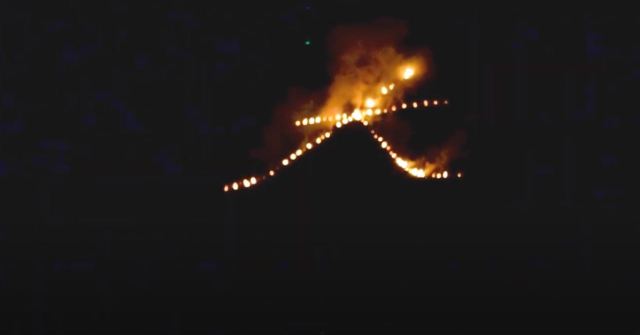
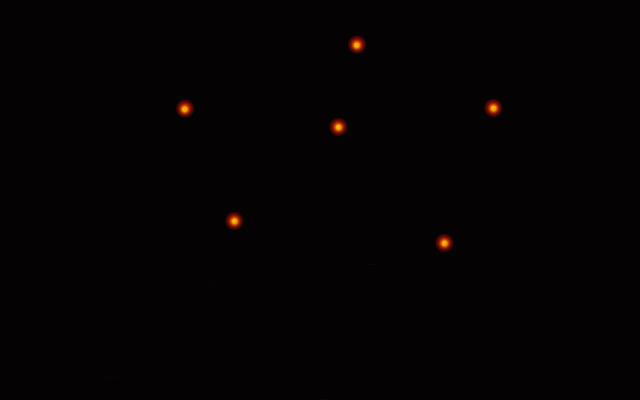
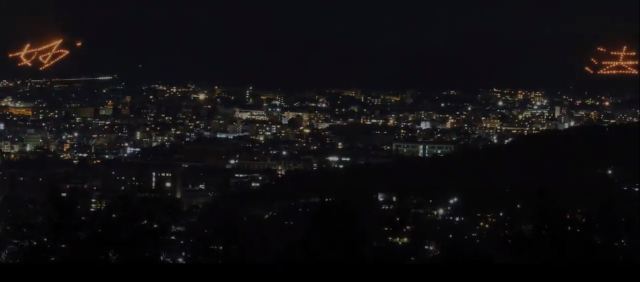

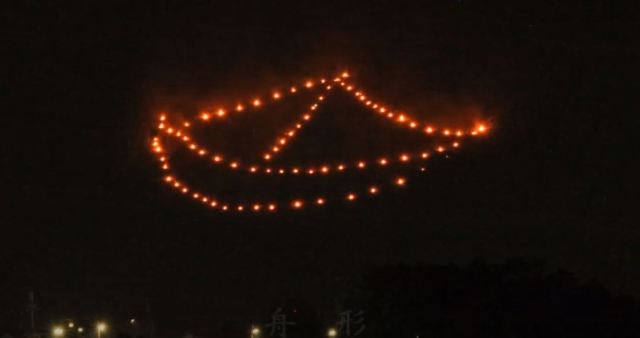

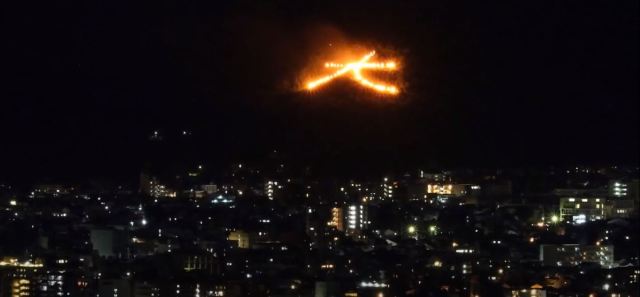

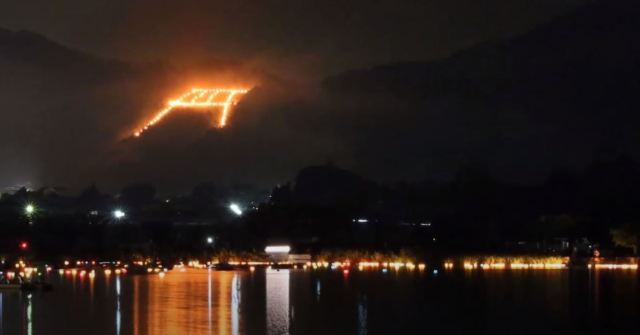

 Organizers angered as ceremonial giant kanji “fire” in Kyoto lit early and unofficially
Organizers angered as ceremonial giant kanji “fire” in Kyoto lit early and unofficially Super-flashy kimono shop Miyabi tells us about the Coming of Age Day situation this year
Super-flashy kimono shop Miyabi tells us about the Coming of Age Day situation this year Leading Japanese snack maker to continue teleworking, stop transferring people from own families
Leading Japanese snack maker to continue teleworking, stop transferring people from own families Traditional Japanese ceramics given new life in AR, delivered straight to your web browser for free
Traditional Japanese ceramics given new life in AR, delivered straight to your web browser for free Mental illness issues could make death penalty impossible for Kyoto Animation arsonist
Mental illness issues could make death penalty impossible for Kyoto Animation arsonist How to order snacks on a Shinkansen bullet train in Japan
How to order snacks on a Shinkansen bullet train in Japan Hello, cosmetics! Clinique teams up with Hello Kitty this summer for first-time collaboration
Hello, cosmetics! Clinique teams up with Hello Kitty this summer for first-time collaboration Demon Slayer: Kimetsu no Yaiba gets new roller coaster attractions and food at Universal Studios Japan
Demon Slayer: Kimetsu no Yaiba gets new roller coaster attractions and food at Universal Studios Japan A visit to the best UFO catcher arcade in the universe!
A visit to the best UFO catcher arcade in the universe! To combat declining birth rate, Japan to begin offering “Breeding Visas” to foreigners
To combat declining birth rate, Japan to begin offering “Breeding Visas” to foreigners Spirited Away train station and submerged tracks attract Ghibli fans around Japan
Spirited Away train station and submerged tracks attract Ghibli fans around Japan Daiso DIY dessert! 100 yen store’s super-easy mochi sweets kit is our new hero
Daiso DIY dessert! 100 yen store’s super-easy mochi sweets kit is our new hero How should you respond when a Japanese person gives you a compliment?
How should you respond when a Japanese person gives you a compliment? New samurai glasses are Japan’s latest weird must-have souvenir
New samurai glasses are Japan’s latest weird must-have souvenir McDonald’s adds new watermelon frappe and fruity macaron to its menu in Japan
McDonald’s adds new watermelon frappe and fruity macaron to its menu in Japan Nintendo history you can feel – Super NES, N64, and GameCube controllers become capsule toys
Nintendo history you can feel – Super NES, N64, and GameCube controllers become capsule toys “The most Delicious Cup Noodle in history” – Japan’s French Cup Noodle wins our heart【Taste test】
“The most Delicious Cup Noodle in history” – Japan’s French Cup Noodle wins our heart【Taste test】 Starbucks releases a cute Frappuccino and Unicorn Cake…but not in Japan
Starbucks releases a cute Frappuccino and Unicorn Cake…but not in Japan Kyoto Tower mascot termination reveals dark side behind cute Japanese characters
Kyoto Tower mascot termination reveals dark side behind cute Japanese characters McDonald’s Japan’s Soft Twist Tower: A phantom ice cream only sold at select branches
McDonald’s Japan’s Soft Twist Tower: A phantom ice cream only sold at select branches Yabai Ramen: What makes this Japanese ramen so dangerous?
Yabai Ramen: What makes this Japanese ramen so dangerous? Finally! Nintendo Japan expands Switch 8-bit controller sales to everybody, Online member or not
Finally! Nintendo Japan expands Switch 8-bit controller sales to everybody, Online member or not Japanese government wants to build luxury resorts in all national parks for foreign tourists
Japanese government wants to build luxury resorts in all national parks for foreign tourists 10 things you should buy at 7-Eleven in Japan
10 things you should buy at 7-Eleven in Japan Studio Ghibli releases anime heroine cosplay dresses that are super comfy to wear
Studio Ghibli releases anime heroine cosplay dresses that are super comfy to wear Woman charged for driving suitcase without a license in Osaka
Woman charged for driving suitcase without a license in Osaka Studio Ghibli unveils My Neighbour Totoro miniature house model
Studio Ghibli unveils My Neighbour Totoro miniature house model Kyoto experiencing problems with foreign tourists not paying for bus fares, but not on purpose
Kyoto experiencing problems with foreign tourists not paying for bus fares, but not on purpose Fighting mild hunger with a Japanese soda that turns into jelly in the stomach【Taste test】
Fighting mild hunger with a Japanese soda that turns into jelly in the stomach【Taste test】 Studio Ghibli’s Howl’s Moving Castle tapestry unveiled in Japan for first time
Studio Ghibli’s Howl’s Moving Castle tapestry unveiled in Japan for first time McDonald’s new Happy Meals offer up cute and practical Sanrio lifestyle goods
McDonald’s new Happy Meals offer up cute and practical Sanrio lifestyle goods Sales of Japan’s most convenient train ticket/shopping payment cards suspended indefinitely
Sales of Japan’s most convenient train ticket/shopping payment cards suspended indefinitely Sold-out Studio Ghibli desktop humidifiers are back so Totoro can help you through the dry season
Sold-out Studio Ghibli desktop humidifiers are back so Totoro can help you through the dry season Japanese government to make first change to romanization spelling rules since the 1950s
Japanese government to make first change to romanization spelling rules since the 1950s Foreigner’s request for help in Tokyo makes us sad for the state of society
Foreigner’s request for help in Tokyo makes us sad for the state of society Ghibli founders Toshio Suzuki and Hayao Miyazaki contribute to Japanese whisky Totoro label design
Ghibli founders Toshio Suzuki and Hayao Miyazaki contribute to Japanese whisky Totoro label design Doraemon found buried at sea as scene from 1993 anime becomes real life【Photos】
Doraemon found buried at sea as scene from 1993 anime becomes real life【Photos】 Tokyo’s most famous Starbucks is closed
Tokyo’s most famous Starbucks is closed Princesses, fruits, and blacksmiths: Study reveals the 30 most unusual family names in Japan
Princesses, fruits, and blacksmiths: Study reveals the 30 most unusual family names in Japan COVID-19 turnabout—pandemic in Japan unexpectedly revives, instead of exterminates, a dying art
COVID-19 turnabout—pandemic in Japan unexpectedly revives, instead of exterminates, a dying art Apprentice geisha fire drill in Kyoto leaves Internet charmed and chuckling【Video】
Apprentice geisha fire drill in Kyoto leaves Internet charmed and chuckling【Video】 Kyoto Animation studio in arson attack found to have been in compliance with all fire codes
Kyoto Animation studio in arson attack found to have been in compliance with all fire codes Purify the hate of Internet jeers with Japanese temple’s first online ceremonial fire
Purify the hate of Internet jeers with Japanese temple’s first online ceremonial fire Kyoto University finds alpacas may hold the key to preventing all COVID-19 variants
Kyoto University finds alpacas may hold the key to preventing all COVID-19 variants Anime studio attacked by arsonist, explosion leaves dozens injured, 12 dead
Anime studio attacked by arsonist, explosion leaves dozens injured, 12 dead 27-year-old in Japan arrested for 3-D printed pistol, says he didn’t know it was illegal
27-year-old in Japan arrested for 3-D printed pistol, says he didn’t know it was illegal Kyoto Animation arson attack prompts call for stricter gas sale regulations in Kyoto
Kyoto Animation arson attack prompts call for stricter gas sale regulations in Kyoto Tokyo Olympic Committee trains 220 “hackers” to protect games
Tokyo Olympic Committee trains 220 “hackers” to protect games Kyoto Animation arsonist’s psychological evaluation ends, open door to prosecution
Kyoto Animation arsonist’s psychological evaluation ends, open door to prosecution Man in charge of cybersecurity for 2020 Olympics has never touched a computer
Man in charge of cybersecurity for 2020 Olympics has never touched a computer AKB48’s Indonesian spin-off group JKT48 forced to downsize due to pandemic
AKB48’s Indonesian spin-off group JKT48 forced to downsize due to pandemic JR East to equip trains station staff with bodycams to protect them from attacks
JR East to equip trains station staff with bodycams to protect them from attacks Japanese transport group aims to set up public ropeway transit system by 2025
Japanese transport group aims to set up public ropeway transit system by 2025 Kyoto Animation releases first 10 minutes of Violet Evergarden movie free to watch online【Video】
Kyoto Animation releases first 10 minutes of Violet Evergarden movie free to watch online【Video】 Japanese soccer team fined 20 million yen because fans’ cheering violated COVID-19 guidelines
Japanese soccer team fined 20 million yen because fans’ cheering violated COVID-19 guidelines
Leave a Reply